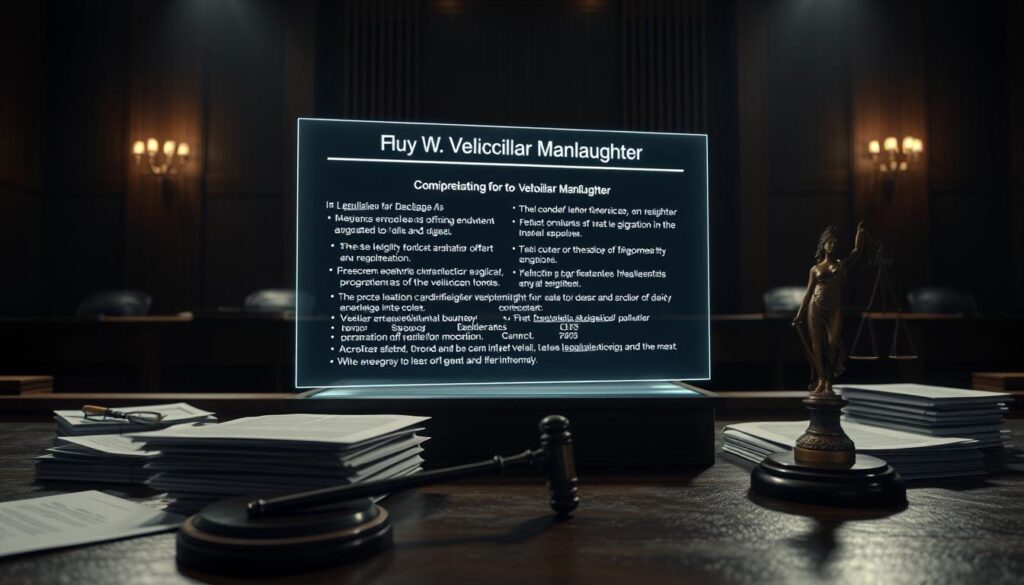Table of Contents
Did you know that the average prison sentence for vehicular manslaughter in Canada ranges between 6 to 8 years? This startling statistic underscores the severity with which the law treats such offenses, reflecting the profound impact on victims’ families and society.
This guide provides an in-depth examination of the legal framework surrounding vehicular manslaughter, focusing on the Criminal Code and real case studies. It’s crucial to understand the legal definitions and sentencing guidelines to navigate this complex area of law effectively.
Readers will gain insights into defense strategies and how judicial discretion influences sentencing. Our approach combines expert knowledge with accessible language, ensuring clarity without compromising on the legal intricacies involved.
Introduction to Vehicular Manslaughter in Canada
Understanding vehicular manslaughter in Canada requires a clear grasp of its legal definitions and distinctions from similar offenses. This section explores the nuances of vehicular manslaughter, comparing it to criminal negligence and dangerous driving.
Defining Vehicular Manslaughter
Vehicular manslaughter refers to a situation where a death occurs due to a violation of motor vehicle rules without the intent to kill. It is a serious charge under Canadian law, often arising from reckless or negligent driving.
Comparing Criminal Negligence and Dangerous Driving
Criminal negligence and dangerous driving are distinct yet related offenses. Criminal negligence involves a blatant disregard for human life or safety, while dangerous driving pertains to operating a vehicle in a manner that endangers others. The key distinction lies in the level of intent and evidence required for each charge.
| Charge | Key Distinctions | Examples | Legal Implications |
|---|---|---|---|
| Criminal Negligence | Reckless disregard for safety | Ignoring traffic lights, speeding excessively | Severe penalties, possible imprisonment |
| Dangerous Driving | Endangering others through driving | Racing, tailgating | Fines, license suspension |
| Vehicular Manslaughter | Death due to traffic violation | Fatal accident from reckless driving | Lengthy imprisonment |
Understanding these distinctions is crucial for drivers to recognize the potential legal consequences of their actions on the road.
As highlighted in the 2016 Ontario case, the mother’s impaired driving led to tragic consequences, underscoring the severity of such charges.
“The legal ramifications of vehicular manslaughter extend beyond immediate penalties, affecting families and communities profoundly.”
Legal Framework for Vehicular Manslaughter
Canada’s legal system addresses vehicular manslaughter through a structured framework that ensures accountability and justice. This framework is rooted in the Criminal Code and influenced by the Canadian Charter of Rights and Freedoms, providing clear guidelines for legal proceedings.
Relevant Sections of the Criminal Code
The Criminal Code outlines specific sections that apply to vehicular manslaughter cases. Section 219 focuses on criminal negligence, while Section 320.13 addresses impaired driving. These sections provide the legal foundation for prosecuting such cases, ensuring that the law is applied consistently.
Role of the Canadian Charter of Rights and Freedoms
The Canadian Charter of Rights and Freedoms plays a crucial role in safeguarding the rights of the accused. It ensures that legal proceedings are fair and that evidence is handled appropriately, protecting individuals from unjust treatment.
| Charge | Relevant Section | Legal Implications |
|---|---|---|
| Criminal Negligence | Section 219 | Severe penalties, possible imprisonment |
| Impaired Driving | Section 320.13 | Fines, license suspension |
| Vehicular Manslaughter | Section 236 | Lengthy imprisonment |

Understanding these legal elements is essential for navigating the complexities of vehicular manslaughter cases in Canada.
Understanding Prison Sentence for Vehicular Manslaughter
In Canada, a prison sentence for vehicular manslaughter is determined based on the severity of the offense and surrounding circumstances. Judicial discretion plays a significant role, as judges consider factors like the driver’s intent, negligence level, and the incident’s impact on victims’ families.
The penalties can range from fines to lengthy imprisonment, depending on whether the offense involved impaired driving or reckless behavior. Case studies reveal that sentences often reflect the gravity of the incident, with aggravating factors leading to harsher penalties. For instance, fleeing the scene can escalate charges and result in longer prison terms.

Judicial decisions are influenced by evidence assessment, including collision reconstruction and toxicology reports. Differentiating between intent and negligence is crucial, as cases involving intent may lead to more severe charges. High-profile cases often highlight the legal system’s approach to such offenses, emphasizing the need for accountability and justice.
Understanding these sentencing guidelines helps individuals grasp the legal consequences of such offenses. Landmark cases illustrate the profound impact of vehicular manslaughter on communities, reinforcing the importance of road safety and responsible driving.
Factors Influencing Sentencing and Penalties
The sentencing process for manslaughter cases, particularly those involving vehicles, is influenced by multiple factors. Negligence and intent are crucial elements that determine the severity of penalties. Drivers who demonstrate reckless behavior or impaired driving face harsher consequences, as their actions show a clear disregard for safety.
Negligence, Intent, and Evidence
In legal terms, negligence refers to a failure to exercise reasonable care, leading to fatal consequences. Intent plays a pivotal role in differentiating between manslaughter and other homicide charges. Evidence such as toxicology reports and collision reconstruction is critical in establishing the driver’s state and intent at the time of the accident.
Impact of Impaired Driving and DUI
Impaired driving significantly escalates penalties due to the heightened risk it poses. Alcohol or drug influence not only increases the severity of charges but can also lead to longer imprisonment and additional fines. According to Canadian legal standards, such cases are treated with extreme seriousness to deter similar offenses.
| Factor | Impact on Sentencing |
|---|---|
| Negligence | Establishes level of culpability, affecting penalty severity |
| Impaired Driving | Increases imprisonment terms and fines |
| Evidence Strength | Directly influences charge severity and sentencing |

Understanding these factors is essential for comprehending how legal outcomes are determined. Thorough investigations and expert legal analysis are vital in navigating the complexities of such cases.
Notable Case Studies and Lessons Learned
Real-life cases provide valuable insights into the legal consequences of vehicular manslaughter in Canada. These incidents highlight the importance of understanding the law and the potential repercussions of reckless driving.
The 2016 Ontario Tragic Incident
In 2016, a devastating collision in Ontario resulted in the loss of multiple lives, shocking the community. This case underscored the severe impact of impaired driving and the legal system’s response to such tragedies.

The collision reconstruction findings revealed that the driver’s impaired state significantly contributed to the accident. This evidence was pivotal in determining the charges and sentence, emphasizing the role of forensic analysis in legal proceedings.
Judicial Perspectives from Collision Reconstruction Findings
Judicial assessments in such cases often highlight the balance between accountability and the complexities of the law. The 2016 Ontario case demonstrated how collision reconstruction provides critical evidence, influencing judicial decisions and sentences.
| Case Detail | Key Evidence | Legal Outcome |
|---|---|---|
| 2016 Ontario Incident | Impaired driving, collision reconstruction | Lengthy imprisonment, fines |
| Collision Reconstruction | Forensic analysis, toxicology reports | Increased penalties |
| Judicial Findings | Driver negligence, reckless behavior | Harsher sentencing |
These cases illustrate the legal system’s approach to vehicular manslaughter, emphasizing the need for rigorous investigations and consistent application of the law.
“The legal ramifications of vehicular manslaughter extend beyond immediate penalties, affecting families and communities profoundly.”
For those facing such charges, consulting legal experts like Sohi Law Group is essential for navigating the complexities of the legal system.
Defense Strategies and Legal Representation
When facing charges related to vehicular manslaughter, securing skilled legal representation is crucial. A qualified lawyer can guide you through the complexities of the legal system and help build a robust defense.
Building a strong legal defense often involves challenging the evidence presented against you. This can include questioning the reliability of witness testimonies or the accuracy of forensic reports. Raising reasonable doubt is a key strategy, as it can significantly impact the outcome of your case.
- Focus on factual evidence and mitigating circumstances.
- Challenge the prosecution’s case through expert testimony.
- Explore potential violations of your rights during police procedures.
Expert legal guidance is essential to navigate these complex charges. If you or someone you know is facing such charges, contact the Sohi Law Group at 833-877-9797 for immediate assistance.

Preventative Measures and Road Safety Best Practices
Preventing tragedies on the road begins with adopting safe driving practices and adhering to traffic laws. Staying vigilant and responsible behind the wheel can significantly reduce the risk of fatal accidents and their legal consequences.
Avoiding impaired driving is one of the most critical steps in ensuring road safety. Alcohol or drugs impair judgment and reaction times, increasing the likelihood of accidents. Stricter enforcement of traffic laws and public awareness campaigns have proven effective in reducing such incidents.
Minimizing distractions while driving is equally important. Texting or using electronic devices can divert attention, leading to dangerous situations. Encouraging drivers to stay focused and avoid multitasking can prevent many accidents.
Negligent behavior, such as speeding or reckless driving, often results in severe legal repercussions. Understanding the consequences of such actions can motivate drivers to adopt safer habits. Proper vehicle maintenance also plays a role in accident prevention, ensuring that cars are in good working condition.
Individual responsibility on the road benefits public safety as a whole. By prioritizing safety, drivers contribute to a safer environment for everyone. Staying informed about traffic rules and adopting a safety-first mindset can significantly reduce the risk of accidents and their legal implications.
For more information on road safety and legal implications, visit Sohi Law Group to explore resources and expert advice.
Conclusion
In conclusion, vehicular manslaughter is a grave offense in Canada, carrying severe legal consequences that can profoundly impact lives. The legal framework outlined in the Criminal Code emphasizes accountability, with penalties ranging from fines to lengthy imprisonment, especially when impaired driving is involved. Understanding the legal definitions and sentencing guidelines is crucial for both drivers and legal professionals navigating these complex cases.
The importance of evidence, such as collision reconstruction and toxicology reports, cannot be overstated. These elements often determine the severity of charges and sentences. Legal defense strategies must carefully challenge evidence and raise reasonable doubt to influence case outcomes. Consulting with experts, like those at Sohi Law Group, is essential for those facing such charges.
Preventive measures, such as responsible driving and adhering to traffic laws, are vital to avoiding tragic incidents. Staying informed and making informed decisions can prevent costly legal outcomes and contribute to road safety. By prioritizing safe driving practices, individuals help create a safer environment for everyone on the road.





No comment